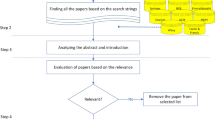Abstract
We address the combinatorial optimization problem of finding the most influential nodes on a large-scale social network for two widely-used fundamental stochastic diffusion models. The past study showed that a greedy strategy can give a good approximate solution to the problem. However, a conventional greedy method faces a computational problem. We propose a method of efficiently finding a good approximate solution to the problem under the greedy algorithm on the basis of bond percolation and graph theory, and compare the proposed method with the conventional method in terms of computational complexity in order to theoretically evaluate its effectiveness. The results show that the proposed method is expected to achieve a great reduction in computational cost. We further experimentally demonstrate that the proposed method is much more efficient than the conventional method using large-scale real-world networks including blog networks.
Similar content being viewed by others
References
Callaway DS, Newman MEJ, Strogatz SH (2000) Network robustness and fragility: percolation on random graphs. Phys Rev Lett 85: 5468–5471
Chung F, Lu L (2002) Connected components in a random graph with given expected degree sequences. Ann Comb 6: 125–145
Domingos P (2005) Mining social networks for viral marketing. IEEE Intell Sys 20: 80–82
Domingos P, Richardson M (2001) Mining the network value of customers. In: Proceedings of the 7th ACM SIGKDD international conference on knowledge discovery and data mining, San Francisco, California, USA, pp 57–66
Even-Dar E, Shapira A (2007) A note on maximizing the spread of influence in social networks. Internet and Network Economics: WINE 2007, LNCS 4858, pp 281–286
Goldenberg J, Libai B, Muller E (2001) Talk of the network: a complex systems look at the underlying process of word-of-mouth. Mark Lett 12: 211–223
Grassberger P (1983) On the critical behavior of the general epidemic process and dynamical percolation. Math Biosci 63: 157–172
Gruhl D, Guha R, Liben-Nowell D, Tomkins A (2004) Information diffusion through blogspace. In: Proceedings of the 7th international World Wide Web conference, New York, USA, pp 107–117
Kempe D, Kleinberg J, Tardos E (2003) Maximizing the spread of influence through a social network. In: Proceedings of the 9th ACM SIGKDD international conference on knowledge discovery and data mining, Washington, DC, USA, pp 137–146
Kempe D, Kleinberg J, Tardos E (2005) Influential nodes in a diffusion model for social networks. Automata, Languages and Programming: ICALP 2005, LNCS 3580, pp 1127–1138
Leskovec J, Adamic LA, Huberman BA (2006) The dynamics of viral marketing. In: Proceedings of the 7th ACM conference on electronic commerce, Ann Arbor, Michigan, USA, pp 228–237
Leskovec J, Krause A, Guestrin C, Faloutsos C, VanBriesen J, Glance N (2007) Cost-effective outbreak detection in networks. In: Proceedings of the 13th ACM SIGKDD international conference on knowledge discovery and data mining, San Jose, California, USA, pp 420–429
McCallum A, Corrada-Emmanuel A, Wang X (2005) Topic and role discovery in social networks. In: Proceedings of the 19th international joint conference on artificial intelligence, Edinburugh, Scotland, pp 786–791
Molloy M, Reed B (1998) The size of the giant component of a random graph with a given degree sequence. Comb Probab Comput 7: 295–305
Newman MEJ (2001) The structure of scientific collaboration networks. Proc Natl Acad Sci USA 98: 404–409
Newman MEJ (2002) Spread of epidemic disease on networks. Phys Rev E 66: 016128
Newman MEJ (2003) The structure and function of complex networks. SIAM Rev 45: 167–256
Newman MEJ, Park J (2003) Why social networks are different from other types of networks. Phys Rev E 68: 036122
Richardson M, Domingos P (2002) Mining knowledge-sharing sites for viral marketing. In: Proceedings of the 8th ACM SIGKDD international conference on knowledge discovery and data mining, Edmonton, Alberta, Canada, pp 61–70
Saito K, Kimura M, Motoda H (2008) Effective visualization of information diffusion process over complex networks. In: Machine learning and knowledge discovery in databases: ECML PKDD 2008, LNAI 5212, pp 326–341
Watts DJ (2002) A simple model of global cascades on random networks. Proc Natl Acad Sci USA 99: 5766–5771
Watts DJ, Dodds PS (2007) Influence, networks, and public opinion formation. J Consum Res 34: 441–458
Acknowledgments
This work was partly supported by JSPS Grant-in-Aid for Scientific Research (C) (No. 20500147), and Asian Office of Aerospace Research and Development, Air Force Office of Scientific Research, US Air Force Research Laboratory under Grant No. AOARD-08-4027.
Author information
Authors and Affiliations
Corresponding author
Additional information
Responsible editor: R. Bayardo.
Rights and permissions
About this article
Cite this article
Kimura, M., Saito, K., Nakano, R. et al. Extracting influential nodes on a social network for information diffusion. Data Min Knowl Disc 20, 70–97 (2010). https://doi.org/10.1007/s10618-009-0150-5
Received:
Accepted:
Published:
Issue Date:
DOI: https://doi.org/10.1007/s10618-009-0150-5




